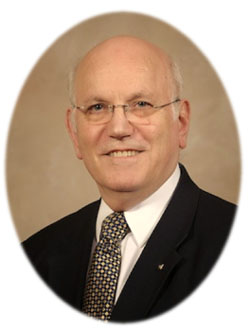 This is a belated tribute to Dr. Roger Pollard, an esteemed collaborator and colleague who passed away last December at the age of 65—much too soon. All in the industry are invited to attend a special session in Roger’s honor during IMS 2012 in Montreal: session TH3H-1, Thursday, June 21, 1:50 to 2:10 p.m., in room 511CF.
This is a belated tribute to Dr. Roger Pollard, an esteemed collaborator and colleague who passed away last December at the age of 65—much too soon. All in the industry are invited to attend a special session in Roger’s honor during IMS 2012 in Montreal: session TH3H-1, Thursday, June 21, 1:50 to 2:10 p.m., in room 511CF.
Dr. Roger Pollard absolutely loved development—of engineering and people. His long list of accomplishments spans both, and perhaps foremost are the 56 successful Ph.D. candidates he supervised during his time at the University of Leeds in the United Kingdom. Four of those Ph.D.s are current or retired members of technical staff at Hewlett-Packard or Agilent Technologies.
Roger’s relationship with HP/Agilent began more than 30 years ago. Here’s how he told the story in the January 2008 issue of Agilent Measurement Journal:
“My Agilent odyssey started in 1981 as a young faculty member at the University of Leeds looking to take a brief sabbatical—one different from the usual route of going to another university in another country to teach the same subjects to someone else’s students. Some research background in network measurements made the HP (now Agilent) division in Santa Rosa, California seem the ideal place, so I penned a request to a conference contact. Three months later, a three-line message asked, ‘Can you start next week?’”
Roger spent the next seven months as part of the team that developed the HP 8510A network analyzer, a landmark product that played a significant role in transforming the microwave industry. He returned to Leeds and settled back into academic life until he received a surprise query the next spring: “When can we expect you?”
And so it went for nearly three decades. Roger and his lovely wife, Anne, spent part of every summer in Santa Rosa. He contributed to projects, provided a fresh perspective, and served as a confidant to many engineers and managers. His visits were eagerly anticipated by our R&D engineers—and the members of my team would often ask, “When will Roger be here? I need to run something by him.”
Through such conversations Roger earned tremendous respect for his technical skills, and many considered him to be a true genius. Across the years, he was a key contributor to several HP/Agilent technical innovations:
- Multiple calibration techniques and algorithms
- The measurement of noise figure in a network analyzer
- Millimeter-wave component measurements and equipment
- On-wafer measurements
- Nonlinear vector network analysis
- Materials measurements
- Time-domain techniques
Those advances were a natural outgrowth of his personal research interests at the University of Leeds: microwave network measurements, calibration and error correction, microwave and millimeter-wave circuits, large-signal and nonlinear device characterization, and terahertz technology. For many years, Leeds has performed some of the world’s best research in the terahertz range.
Within the broader engineering community, Roger was a long-time volunteer for the IMS, MTTS, IEEE and ARFTS. He served as IEEE Vice President for Technical Activities, IEEE Board of Directors Secretary and MTTS President. As Chair of the TAB/PAB Products Committee, Roger provided the leadership for the creation of IEEE Xplore, which has evolved into a world-class resource for technical information.
Across all that he accomplished, Roger will be best remembered for his leadership and people skills. When I asked his colleagues to describe their memories of Roger, here is what they had to say:
- Leadership: The ability to simplify complexity, to harmoniously blend strong-willed engineering talents, to motivate engineers to do better work, and to mentor engineers.
- Infectious enthusiasm: His sense of humor, a passion for people, the constant delivery of encouragement, and an ability to make the Smith chart exciting (no small feat, that).
- Depth and curiosity: A deep interest in subjects beyond engineering—politics, monetary policy, culture, language, and even construction methods.
- Technical ability: A genius-level intellect that was innovative but also practical and down-to-earth.
In March 2011, after Roger had retired as dean of engineering of Leeds, we were fortunate to bring him on as an official employee. We often joked that he was our longest-tenured summer intern because it took us 30 years to finally hire him. He told me it had been a dream of his to work for HP/Agilent after completing his academic career. He had it backwards: It was our dream to have him join us.
Personally, I thoroughly enjoyed my weekly one-on-one meetings with Roger. Our conversations were filled with technical discussions as well as his novel ideas, his advice, and a fair bit of humor. Going forward, I’ll certainly miss the privilege of counting on his technical brilliance—but it’s his leadership and people skills I’ll miss the most. He made me a better leader, and made all of us better engineers.
Perhaps the best way to think about Roger—at least from an HP/Agilent perspective—is he didn’t think outside the box. How could he? He never saw a box.

